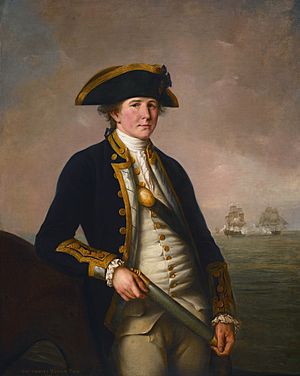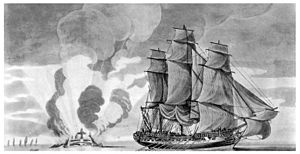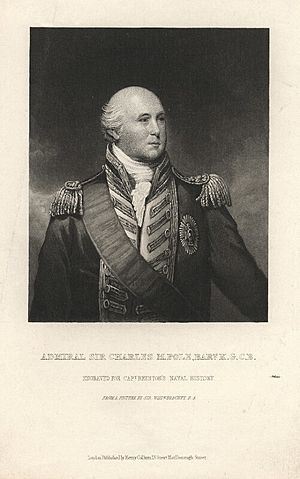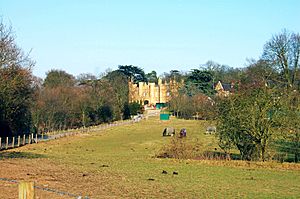Sir Charles Pole, 1st Baronet facts for kids
Quick facts for kids
Sir
Charles Pole
|
|
|---|---|

Charles Morice Pole (John Francis Rigaud, 1781)
|
|
| Governor of the Bank of England | |
| In office 1820–1822 |
|
| Preceded by | George Dorrien |
| Succeeded by | John Bowden |
| Personal details | |
| Born | 18 January 1757 |
| Died | 6 September 1830 (aged 73) Aldenham Abbey, Hertfordshire |
| Occupation |
|
| Military service | |
| Allegiance | |
| Branch/service | |
| Years of service | 1770–1806 |
| Rank | Admiral of the Fleet |
| Commands | HMS Cormorant HMS Britannia HMS Hussar HMS Success HMS Crown HMS Melampus HMS Illustrious HMS Colossus Baltic Fleet |
| Battles/wars | American Revolutionary War French Revolutionary Wars Napoleonic Wars |
| Awards | Knight Grand Cross of the Order of the Bath |
Sir Charles Morice Pole (born January 18, 1757 – died September 6, 1830) was a very important person in British history. He was an Admiral of the Fleet in the Royal Navy, which is the highest rank a naval officer can achieve. He also served as a governor in a colony and later became a banker.
During his long career, Sir Charles fought in several major wars. These included the American Revolutionary War, the French Revolutionary Wars, and the Napoleonic Wars. He was known for his bravery and leadership at sea. After his time in the navy, he took on important roles in government and finance. From 1820 to 1822, he even served as the Governor of the Bank of England, which is a very powerful position.
Contents
Charles Pole began his journey at a young age. He joined the Royal Naval Academy in Portsmouth in January 1770 when he was just 13 years old. This was the start of his exciting career at sea.
His first assignments were on ships like HMS Thames and HMS Salisbury. In 1777, he became a lieutenant. He then served on HMS Seahorse and HMS Rippon.

One of his early battles was the siege of Pondicherry in India in 1778. This happened during the American Revolutionary War. After this, he commanded a small ship called HMS Cormorant.
In 1779, Charles Pole was promoted to captain. He commanded several ships, including HMS Britannia. Later, on HMS Success, he had a famous victory. In March 1782, he captured and destroyed a Spanish warship called Santa Catalina in the Strait of Gibraltar. This was a big achievement for him.
After the war ended, Pole continued to command ships. He also became a special assistant to the Duke of Clarence in 1789. He commanded HMS Melampus and HMS Illustrious.
In 1793, he commanded HMS Colossus. He captured a French privateer (a private ship allowed to attack enemy ships) named Vanneau. He then took part in the siege of Toulon during the early stages of the French Revolutionary Wars.
Rising Through the Ranks
Charles Pole continued to rise in the navy. In 1795, he became a rear-admiral. He served as the second-in-command of the West Indies Station. Later, he became the Captain of the Fleet in the Channel Squadron.
During this time, there were serious strikes by sailors known as the Spithead mutiny. Sailors were demanding better pay and conditions. Pole was involved in advising the Admiralty (the navy's leadership) on how to handle the situation.
In 1800, Pole was appointed governor and commander-in-chief of Newfoundland. This was a British colony in North America. When he arrived, there was a serious outbreak of smallpox. He worked hard to deal with the disease, using new methods like inoculation (an early form of vaccination). He also helped set up a committee to help poor people.
In 1801, he was promoted to vice-admiral. He then took command of the Baltic Fleet, which was a group of warships in the Baltic Sea.
In August 1801, he was given the special title of baronet. This meant he could be called "Sir Charles Morice Pole, 1st Baronet." He also became a Member of Parliament for Newark in 1802.
In 1805, he became a full admiral. He even attended the funeral of the famous Admiral Lord Nelson in 1806. He also served on the Admiralty Board, which helped run the navy.
Later Life and Achievements
Sir Charles Morice Pole continued to serve his country in various ways. He was elected Member of Parliament for Plymouth in 1806.
He received more honors for his service. In 1815, he was made a Knight Commander of the Order of the Bath. Then, in 1818, he became a Knight Grand Cross of the Order of the Bath. These were very high awards.
In 1818, he became the Deputy Governor of the Bank of England. Two years later, in 1820, he became the Governor of the Bank of England itself. This was a very important role in the country's finances.
In 1824, he became the Sheriff of Hertfordshire. Finally, in July 1830, he was promoted to the highest naval rank: Admiral of the Fleet. Sir Charles Morice Pole passed away at his home, Aldenham Abbey, on September 6, 1830.
Family
In 1792, Sir Charles Pole married Henrietta Goddard. They had two daughters together.
See also
- Governors of Newfoundland
- List of people from Newfoundland and Labrador



